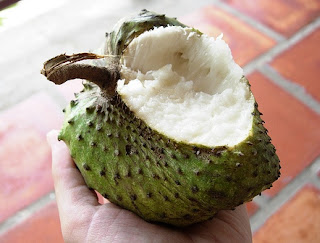Botanical name: Annona
reticulata
Common names: Custard apple,
cherimoya, guanabana, soursop, tomoko, matomoko or brazilian paw paw.
Sometimes it is called wild-sweetsop, bull's heart, bullock's-heart,
Budha’s head or ox-heart.
Annona
(from Taíno annon) is a genus of flowering plants in the pawpaw/sugar apple
family.
Custard apple (Matomoko) is
a small deciduous or semi-evergreen tree in the plant family Annonaceae,
growing 4 to 8 meters high and bearing a smooth, heart-shaped fruit with small
depressions on the surface. It is the
second largest genus in the family after Guatteria, containing approximately
166 species of mostly tropical trees
and shrubs.
Other two closely related
species are: Annona cherimola or
muricata (Soursop) and Annona.
squamosa (Sugar-apple). For more here
Photo credit: Health benefits
Custard apple is a
subtropical deciduous woody shrub that has branches that spread irregularly and
can reach 8 metres high under favorable conditions. Mostly growing between
altitudes of 0 metre to 1,500 metres above sea level. It can therefore
grow in most ASALs in Kenya
 The custard apple is
available in various dry parts of the country including Taita, Ukambani, and
Kirinyaga. It is mostly found in Kitui, Machakos, Kibwezi, Makueni, Voi, Taita and sold in urban
centre markets during its season. The tomoko fruit that grows in some highlands
areas within Murang’a and Kirinyaga is larger in size than the hybrids growing
more commonly in dryland areas of the country.
The custard apple is
available in various dry parts of the country including Taita, Ukambani, and
Kirinyaga. It is mostly found in Kitui, Machakos, Kibwezi, Makueni, Voi, Taita and sold in urban
centre markets during its season. The tomoko fruit that grows in some highlands
areas within Murang’a and Kirinyaga is larger in size than the hybrids growing
more commonly in dryland areas of the country. Most farmers here in Kitui have less than 10 trees and single trees have been spotted in some homesteads. Most open air markets here have these fruits. Custard apple is spotted in most major markets in Nairobi as well.
The fruit is lumpy skinned
with a soft sweet pulp that is rich in various nutrients. Compared to soursop,
custard apple is more common in Kenya. The flavor of the fruit is sweet and
pleasant, but less popular than that of A. cherimola.
Custard apple has still not
gained much popularity but there is possibility to expand its use and
importance.
Matomoko Magics.
· It is praised for its strong ability to fight
cancer cells, as well as a host of other health benefits. The bark, leaves,
root, and fruits of the graviola tree to treat infections with viruses or
parasites, rheumatism, arthritis, depression, and sickness.
· It is said to have components that destroy
lung, breast, prostate, colon, liver, ovarian, cervical, breast, bladder and
skin cancerous cells. A study by the Catholic University of South Korea
published in the Journal of Natural Products found that an extract from the
fruit’s plant was 10,000 times more efficient in killing colon cancer cells
compared to Adriamycin (medication that is popular for chemotherapy).
· Custard apples have anti-oxidants such as
Vitamin C, which helps to combat free radicals in the body. The fruit contains
Vitamin A, which is good for keeping the hair and skin healthy.
· Tomoko is also known to be high in magnesium.
This is great for balancing the water levels in our bodies, as well as
assisting to eliminate acids from the joints hence reducing the symptoms of
arthritis and rheumatism.
· The magnesium also protects the heart from
cardiac diseases.
· It is also high in potassium, which helps to
fight muscle weakness. Again, the copper
present in the fruit is effective in helping to treat constipation, as well as
diarrhoea and dysentery.
· Custard apples are also known to be a rich
source of dietary fiber, usually required for maintaining a healthy digestive
tract.
Nutritional
Value of Raw Matomoko
Energy
423 kJ
(101 kcal)
Carbohydrates 25.2
g
Dietary
fiber 2.4 g
Fat 0.6 g
Protein 1.7 g
Vitamins Quantity %DV†
Thiamine
(B1) 0.08 mg 7%
Riboflavin
(B2) 0.1 mg 8%
Niacin
(B3) 0.5 mg 3%
Pantothenic
acid (B5) 0.135 mg
3%
Vitamin
B6 0.221 mg 17%
Vitamin
C 19.2 mg 23%
Minerals Quantity %DV†
Calcium 30 mg 3%
Iron 0.71 mg 5%
Magnesium 18 mg 5%
Phosphorus 21 mg 3%
Potassium 382 mg 8%
Sodium 4 mg 0%
HOW TO EAT OR TAKE MATOMOKO
The easiest way to eat custard apples is to just cut it in half or pull
apart with your hands and use a spoon to scoop out the flesh to eat.
Try adding a little lime juice for a complementary flavour
Ripen darker green fruit at room temperature, once ripe store in the fridge and eat within two days.
There are many other ways to eat custard apples and enjoy the fruit. Make a puree of the flesh by either blending/food processing or pushing the custard apple flesh through a sieve with a wooden spoon, discarding the seeds and any overly fibrous parts.
Try mixing a cup of chopped custard apples into a stir fry, a bowl of chicken salad,
More suggestions
- Use the smoothie or puree for making or adding to sorbet, ice cream, yoghurt or baking in muffins and cakes.
- How about a custard apple cocktail – in a food processor combine the puree of half a custard apple with 45ml, 30ml orange liqueur, 30ml lime juice and a handful of crushed ice.
- For a warm treat, try stirring some de-seeded segments into a green chicken curry in the last few minutes of cooking.
SCIENTIFIC
PROOFS
The custard apple or the fruit from the
graviola tree is a miraculous natural cancer cell killer 10,000 times stronger
than Chemo.
The principal interest in this plant is
because of its strong anti-cancer effects. Although it is effective for a
number of medical conditions, it is its anti tumor effect that is of most
interest. This plant is a proven cancer remedy for cancers of all types.
Besides being a cancer remedy, graviola (active ingredient in the fruit) is a broad spectrum antimicrobial agent for both bacterial and fungal infections, is effective against internal parasites and worms, lowers high blood pressure and is used for depression, stress and nervous disorders.
Besides being a cancer remedy, graviola (active ingredient in the fruit) is a broad spectrum antimicrobial agent for both bacterial and fungal infections, is effective against internal parasites and worms, lowers high blood pressure and is used for depression, stress and nervous disorders.
This fruit is said to kill
cancer more effectively than chemotherapy drugs and does not produce the same
undesirable side effects, but may not be fully clear of any adverse
effects.
Currently graviola exists on
the market under the brand name of Triamazon but licensing of the product is
not generally accepted in all countries due to the potential profit loss
for pharmaceutical companies. Graviola is not just a cancer
treatment, it has also displayed anti-parasitic, antimicrobial,
anti-inflammatory, antirheumatic and cytotoxic properties, according to
Memorial Sloan-Kettering Cancer Center. In some cases, Graviola has also been
used as a pain killer and the results were positive.
In an assessment of
Graviola, published in the December 2008 issue of the “Journal of Dietary
Supplements” by U.S. researchers Lana Dvorkin-Camiel and Julia S.
Whelan, multiple in-vitro studies determined that Graviola is effective
against various microbial and parasitic agents. Graviola displayed specific
effectiveness on parasites Leishmania braziliensis, Leishmania panamensis,
Nippostrongylus braziliensis, Artemia salina and Trichomonas vaginalis, as well
as against the Herpes simplex virus. Read
more here
The extracts of various
parts of Annona reticulata L. have been reported as cytotoxic to many
cancer cells. Annona reticulata L. leaves' methanolic extract (ARME) was
prepared and used against the breast cancer cells. The breast cancer cells
(T-47D) viability and IC50 were evaluated by Vybrant® MTT Cell Proliferation
Assay Kit. Detection of phosphatidylserine on membranes of apoptotic cells was
done by Attune flow cytometer. RNA transcripts were quantified in ARME treated
and untreated cells. Finally, the Vybrant® FAM Poly Caspases assay kit was used
for analysis of polycaspases activity in T-47D cells. The IC50 (5 ±
0.5 µg/mL) of the ARME was found against breast cancer cells (T-47D). The
Paclitaxel was used as a control standard drug for the study. The
downregulation of Bcl-2 and upregulation of Bax and Bak, and caspases
activation suggested induction of apoptosis in T-47D cells by ARME through
mitochondrial pathway. The cell cycle halted at G2/M phase in the ARME treated
cells. The ARME was found to be effective against Breast cancer cells (T-47D). Read
more here
The effect of ethanolic extract of seeds of Annona
reticulata, was investigated in rats to evaluate antiulcer activity by using
pyloric ligation ulcer model and the phytochemical studies were also carried
out. The parameters taken for antiulcer activity were the total gastric volume
secretion, total acidity, pH and ulcer index. Ethanolic extract of seeds of
Annona reticulata significantly (p < 0.001) decreased gastric volume
secretion (2.1 mL), total acidity (92 meq/L/100 g), and ulcer index (33.4). More
here
Side Effects Of Custard Apples:
- Custard apple is very cold in nature, so do not consume it in excess amounts as it can make one sick.
- The seeds of custard apple fruit are poisonous. Do not consume it.
- Since these fleshy, creamy fruits are rich in sugar, diabetes patients are advised to not consume custard apple in high amounts.
Read 32 Amazing Benefits And Uses Of Custard Apples here…
References
- "Annona reticulata". Germplasm Resources Information Network (GRIN). Agricultural Research Service (ARS), United States Department of Agriculture (USDA). Retrieved 16 July 2018.
- Natural Resources Conservation Service (NRCS). "PLANTS Profile, Annona reticulata L". The PLANTS Database. United States Department of Agriculture. Retrieved July 2018.
- "Annona cherimola". Germplasm Resources Information Network (GRIN). Agricultural Research Service (ARS), United States Department of Agriculture (USDA). Retrieved 17 July 2018.
- "Annona squamosa". Germplasm Resources Information Network (GRIN). Agricultural Research Service (ARS), United States Department of Agriculture (USDA). Retrieved 17 July 2018.
- Mahdeem, H. (5 July 1998). "Annona reticulata". Neglected Crops. Department of Horticulture & Landscape Architecture, Purdue University. Archived from the original on 11 May 2008. Retrieved 16 July 2018..
- Aluka. "Entry for Annona reticulata Linn. [family ANNONACEAE]". African Plants. Ithaka Harbors, Inc. doi:10.5555/AL.AP.UPWTA.1_232 (inactive 2018-05-30). Retrieved 16 July 2018.
- Bioversity International. "Result set for: Annonaceae Annona reticulata". New World Fruits Database. Retrieved 16 July 2018.













i am very happy to share this little awesome testimony about Dr AZIBA a great herbal doctor who help me enlarge my penis size.3.2 cm to 8.3 cm longer with his herbal cream mixture, my girlfriend is now so amazed with the autonomous size of my penis , if you you are also in need of help on how to enlarge your penis to become bigger and stronger I advice you to contact Dr Aziba on his email ( PRIESTAZIBASOLUTIONCENTER@GMAIL COM ) you or contact on whatsapp number +2348100368288 because he is one of the best herbal doctor that i can only show you up to, if your penis is 4.2 cm and want to get it reach 9.2 cm within three weeks Dr AZIBA is also specialized on breast and boobs enlargement i advise you to contact him for help DR AZIBA whatsapp number +2348100368288
ReplyDelete